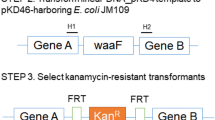Abstract
Recently, cytidine is gaining more attention as a precursor for antiviral drugs. Cytidine is produced by some microorganisms fermentation. Cytidine producing strain Escherichia coli CYT20 was bred in our previous study. Glucose, (NH4)2SO4, and temperature were selected as variables for optimization of fermentation medium and conditions for cytidine production. Among ingredients, different concentrations of initial glucose and (NH4)2SO4 had positive effects on cytidine production, and pH 7.0 and temperature 36 °C were favoured fermentation conditions for cytidine production by E. coli CYT20. After shake flask batch fermentation, production of cytidine was measured by high performance liquid chromatography. The results showed that it was 1,866 mg/l under optimized condition and it was 1,115 mg/l under un-optimized condition, cytidine production was increased by 67.4 %.
Access this chapter
Tax calculation will be finalised at checkout
Purchases are for personal use only
Similar content being viewed by others
References
Asahi S, Tsunem Y (1994) Cytidine production by mutants of Bacillus subtilis. Biosci Biotech Biochem 58(8):1399–1402
Headrick JP, Ely SW, Matherne GP (1993) Methods for cytidine determination. Am J Physiol 264(1):31
Switzer RL (2009) Discoveries in bacterial nucleotide metabolism. J Biol Chem 284(11):6585–6594
Zhu J, Thakker C, San K-Y, Bennett G (2011) Effect of culture operating conditions on succinate production in a multiphase fed-batch bioreactor using an engineered Escherichia coli strain. Appl Microbiol Biotechnol 92(3):499–508
Wang J, Zhu J, Bennett GN, San K-Y (2011) Succinate production from different carbon sources under anaerobic conditions by metabolic engineered Escherichia coli strains. Metab Eng 13(3):328–335
Lin HY, Neubaur P (2000) Influence of controlled glucose oscillations on a fed-batch process of recombinant Escherichia coli. Biotechnology 79:27–37
Rahmen N, Kunze M, Büchs J (2011) Influence of recombinant protein production on respiration activity of E. coli shake flask cultures in auto induction media. Osaka Mini Symposium, Osaka University
Tramper J, Asahi S (1989) Methods for production of cytidine and deoxycytidine. Patent 4839285
Tyge G, Thomas A (2003) High-temperature liquid chromatography. J Chromtogr A 1000(12):743–755
Park KH, RubinL EG (1992) Research on determination of cytidine by reversed phase chromatography. Cric Lation Res 71(4):992
Carneiro S, Villas-Bôas SG, Eugénio C, Ferreira EC, Rocha I (2011) Metabolic footprint analysis of recombinant Escherichia coli strains during fed-batch fermentations. Mol BioSyst 7:899–910
Xiufu H, Daidi F, Yane L (2006) Kinetics of high cell density fed-batch culture of recombinant Escherichia coli producing human-like collagen. Chin J Chem Eng 14:242–247
Lennox B, Montague GA, Hiden HG, Kornfeld G, Goulding PR (2001) Process monitoring of an industrial fed-batch fermentation. Biotechnol Bioeng 74(2):125–135
Bakonyi P, Nemestóthy N, Lövitusz É, Bélafi-Bakó K (2011) Application of Plackett- Burman experimental design to optimize biohydrogen fermentation by E. coli (XL1-BLUE). Int J Hydrogen Energy 36(21):13949–13954
Acknowledgments
We thank colleagues for critical reading of the manuscript and providing valuable suggestions. This work was supported by the Research Program of Tianjin University of Science and Technology (20100211), by Program for Changjiang Scholars and Innovative Research Team in University (IRT 1166), and by the Research Program of University in Ningxia (2012).
Author information
Authors and Affiliations
Corresponding author
Editor information
Editors and Affiliations
Rights and permissions
Copyright information
© 2014 Springer-Verlag Berlin Heidelberg
About this paper
Cite this paper
Fang, H., Xie, X., Xu, Q., Zhang, C., Chen, N. (2014). Effects of Medium Components and Fermentation Conditions on Cytidine Production by Recombinant Escherichia coli CYT20. In: Zhang, TC., Ouyang, P., Kaplan, S., Skarnes, B. (eds) Proceedings of the 2012 International Conference on Applied Biotechnology (ICAB 2012). Lecture Notes in Electrical Engineering, vol 249. Springer, Berlin, Heidelberg. https://doi.org/10.1007/978-3-642-37916-1_2
Download citation
DOI: https://doi.org/10.1007/978-3-642-37916-1_2
Published:
Publisher Name: Springer, Berlin, Heidelberg
Print ISBN: 978-3-642-37915-4
Online ISBN: 978-3-642-37916-1
eBook Packages: EngineeringEngineering (R0)




